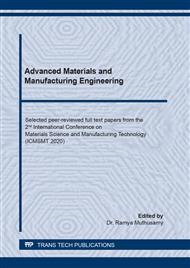[1]
AitanaSáez-de-GuinoaVilaplana, Víctor J. Ferreira, Ana M. López-Sabirón, Alfonso Aranda-Usón, Cristina Lausín-González, Cecilia Berganza-Conde, Germán Ferreira, Utilization of LFS from a steelwork for laboratory-scale production of Portland cement, Constr. Build. Mater. 94 (2015) 837–843.
DOI: 10.1016/j.conbuildmat.2015.07.075
Google Scholar
[2]
B.Singh, IshwaryaG., M.Gupta, S.K. Bhattacharyya, Geopolymer concrete: A review of some recent developments, Volume 85, 15 June 2015, Pages 78-90.
Google Scholar
[3]
Boukendakdji O, Kadri EH, Kenai S. Effects of granulated blast furnace slag and superplasticizer type on the fresh properties and compressive strength of self-compacting concrete. Cement Concr Compos 2012;34:583e90.
DOI: 10.1016/j.cemconcomp.2011.08.013
Google Scholar
[4]
B. Singh, G. Ishwarya, M. Gupta, S.K. Bhattacharyya, Geopolymer concrete: are view of some recent developments, Constr. Build. Mater. 85 (2015) 78–90.
DOI: 10.1016/j.conbuildmat.2015.03.036
Google Scholar
[5]
Chindaprasirt P, Chareerat T, Sirivivatnanon V. Workability and strength of coarse high calcium fly ash geopolymer. Cement Concr Compos 2007; 29:224-9.
DOI: 10.1016/j.cemconcomp.2006.11.002
Google Scholar
[6]
Deb PS, Nath P, Sarker PK. Properties of fly ash and slag blended geopolymer concrete cured at ambient temperature. In: 7th International structural engineering and construction conference, Honolulu, USA; (2013).
DOI: 10.3850/978-981-07-5354-2_m-55-433
Google Scholar
[7]
Davidovits J. Chemistry of geopolymeric systems, terminology. In: Proceedings of Geopolymer International Conference. Saint-Quentin, France; 1999 Jun 30 and Jul 1-2.
Google Scholar
[8]
Deng-Fong Lin, The curing conditions on the properties of geopolymer produced by the calcined oil-contaminated clay, in: 2014 International Conference on Sustainable Development and Disaster Prevention in Civil Engineering, (2014).
Google Scholar
[9]
Hadi MNS, Farhan NA, Sheikh MN. Design of geopolymer concrete with GGBFS at ambient curing condition using Taguchi method. Construct Build Mater 2017;140:424e31.
DOI: 10.1016/j.conbuildmat.2017.02.131
Google Scholar
[10]
Gökhan Kürklü, The effect of high temperature on the design of blast furnace slag and coarse fly ash-based geopolymer mortar, Compos. B 92 (2016) 9–18.
DOI: 10.1016/j.compositesb.2016.02.043
Google Scholar
[11]
J.Provis, Introduction and scope, in: J.L. Provis, J.S.J. van Deventer (Eds.), Alkali Activated Materials: State of the Art Report, RILEM TC 224-AAM, Springer, 2014, p.1–9.
DOI: 10.1007/978-94-007-7672-2_1
Google Scholar
[12]
K.A. Komnitsas, Potential of geopolymer technology towards green buildings and sustainable cities, in: International Conference on Green Buildings and Sustainable Cities, Procedia Engineering, vol. 21, 2011, p.1023–1032.
DOI: 10.1016/j.proeng.2011.11.2108
Google Scholar
[13]
Mehta PK. Reducing the environmental impact of concrete. ACI Concr Int 2001;23(10):61–6.
Google Scholar
[14]
Ping Duan, Chunjie Yan, Wei Zhou, Wenjun Luo, Fresh properties, mechanical strength and microstructure of fly ash geopolymer paste reinforced with saw dust, Constr. Build. Mater. 111 (2016) 600–610.
DOI: 10.1016/j.conbuildmat.2016.02.091
Google Scholar
[15]
P. Duxson, A.Ferna´ndez-Jime´nez, J. L. Provis, G. C. Lukey, A. Palomo, J. S. J. van Deventer, Geopolymer technology: the current state of the art, J Mater Sci (2007) 42:2917–2933.
DOI: 10.1007/s10853-006-0637-z
Google Scholar
[16]
S. Alonso, A. Palomo, Alkaline activation of metakaolin and calcium hydroxide mixtures: influence of temperature, activator concentration and solids ratio, Mater. Lett. 47 (2001) p.5–6.
DOI: 10.1016/s0167-577x(00)00212-3
Google Scholar


